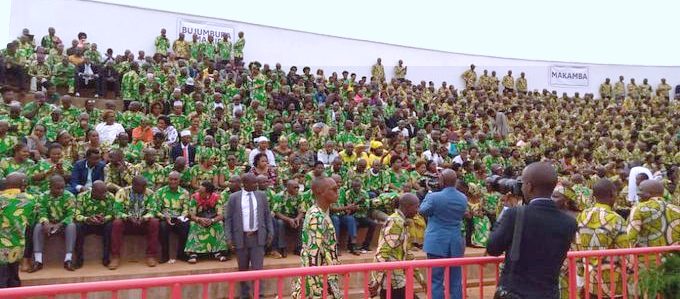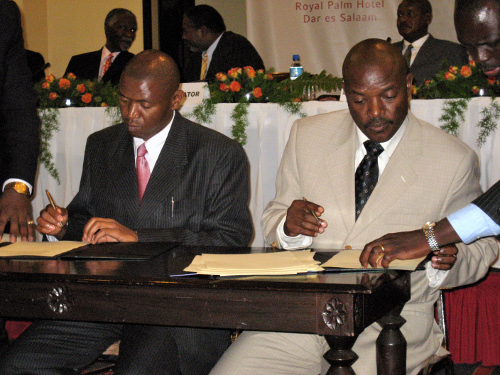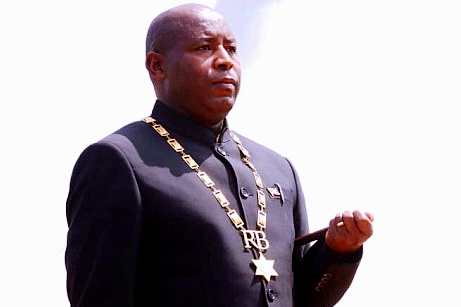
Members of the Burundi military. (Photo: US Army Africa)
Barely two weeks after an election marked by government violence, intimidation, extrajudicial killings, and a media blackout, Burundians were shocked by news that longtime president, Pierre Nkurunziza, 55, had died. Rumors swirled about possible causes, with some saying he died of COVID-19 and others citing foul play. The government said he died of cardiac arrest. A succession crisis immediately ensued, exposing rifts in the ruling party and military.
General Evariste Ndayishimiye, the ruling party candidate widely known by his guerrilla nickname Neva (“never”), claimed a landslide victory in the May 20 presidential elections in a process that was widely seen as unfair. Recognizing that the playing field was not level, the African Union didn’t send observers. On May 11, 9 days before the polls, Burundi authorities informed East African Community observers that they would face a mandatory 14-day quarantine because of COVID-19. The observers, consequently, pulled out. Over 200 of the opposition National Freedom Council’s poll observers were illegally detained. Burundi’s highly respected Catholic Bishops Conference did field 2,716 observers in all 119 municipalities, however. And they denounced the polls as neither free nor fair based on their tally. The government reacted by demanding the bishops be defrocked. On June 4, the seven-member Constitutional Court—all ruling party appointees—threw out the opposition’s petition to annul the results.
The quarantine for external poll observers is ironic given Burundi’s disregard for World Health Organization (WHO) safety guidelines. Campaign rallies drew large crowds without masks or social distancing. Three weeks before polling, Nkurunziza downplayed the risks, claiming that masks were unnecessary because “God has purified the air of Burundi.” He then expelled the WHO coronavirus task force for “unacceptable interference.” Burundi now faces a spike in underreported cases.
“Nkurunziza’s legacy of patronage-based and repressive governance means whoever controls the levers of power has wide scope for self-enrichment and violence.”
This series of crises came on top of an ongoing political upheaval that erupted in 2015 when Nkurunziza refused to step down at the end of his second constitutionally mandated term. This violation of Burundi’s fledgling democratic process triggered massive peaceful protests, a violent crackdown against civil society and the political opposition, targeted assassinations in the military, and a failed coup. Burundi has known turbulence since then, with an estimated 1,700 people having been killed and close to 500,000 of the country’s 11 million citizens now refugees. The United Nations Commission of Inquiry on Human Rights in Burundi has noted that the death toll is grossly undercounted given the scale of mass atrocities committed. This is corroborated by hundreds of eyewitness testimonies, data obtained through government sources, and mass graves discovered around the country.
Nkurunziza’s legacy of patronage-based and repressive governance means whoever controls the levers of power has wide scope for self-enrichment and violence against their rivals. This is all the more significant given Burundi’s history of ethnically based violence and the potential for greater regional instability.
Shifting Power Dynamics

Pierre Nkurunziza.
Under Nkurunziza and the ruling National Council for Defense of Democracy/Forces for the Defense of Democracy (CNDD/FDD), factions within the state and party organs had established informal, multi-layered power structures. These structures were built around the Head of State, the Minister of State Security, the Director General of National Intelligence, the CNDD/FDD Secretary General, and the Chiefs of Staff of the Presidency’s Civil Cabinet, Police Affairs, and Military Affairs. As Chief of Military Affairs, Ndayishimiye oversaw the Imbonerakure, the party militia, which was responsible for much of the intimidation and violence against civilians during Nkurunziza’s tenure. Under these parallel chains of command, orders ran through a network of loyalties dating back to the Burundi’s ethnically driven civil war (1993-2005).
This process also entailed dismantling the Arusha Peace and Reconciliation Agreement that had been created in the aftermath of the civil war to establish safeguards against abuse of power and provide mutual assurances to both the Tutsi minority and Hutu majority. The Accords created a unified army by balancing the predominantly Tutsi ex-Burundi Armed Forces (ex-FAB) and the predominantly Hutu Armed Political Movements (PMPA), of which the CNDD/FDD was one component. Under Nkurunziza, the CNDD-FDD chipped away at the delicate mechanisms put in place to achieve parity under the Arusha Accords. What emerged was a political process and security sector dominated by the CNDD/FDD and their Hutu nationalist ideology.
In the process, the rump military became highly politicized. The most powerful faction is known as the Committee of Generals (sometimes called the Nonoka Association), consisting of CNDD/FDD civil war commanders. Eventually, Nkurunziza himself was not able to control the deep politicization of the military. On the eve of the January 2020 CNDD/FDD Congress, the Committee of Generals forced him to install Ndayishimiye as flagbearer for the May elections, upsetting his plans to hand power to the Secretary General and Speaker of the Assembly, Pascal Nyabenda, who the 2019 United Nations Commission of Inquiry on Human Rights in Burundi report identifies as a leader of one of the parallel power structures inside the presidency.

A CNDD/FDD rally in the days prior to the May 20 elections.
Under a Russia-style triumvirate written into the party Constitution, Nkurunziza was to continue as “Supreme Eternal Guide,” with powers to veto decisions by the President and Prime Minister. The expectation was that all three would come from the same faction of the party. Nyabenda’s ouster caused consternation in the party and intensified jockeying among its factions. It was also seen as an open challenge to the party leader, shaking it to its foundations. Nonetheless, Ndayishimiye’s supporters held firm. Reflective of the Hutu nationalist origins of the CNDD-FDD, they wanted a fellow military man and comrade from their days as Hutu rebels—and someone seen as even more hardline than Nkurunziza.
Reflective of the ongoing jockeying for influence within the CNDD/FDD, Ndayishimiye was forced to select General Alain Guillaume Bunyoni as Prime Minister. Bunyoni heads up another faction within the Committee of Generals, is an ally of Nyabenda, and is the leader of one of the parallel power structures that exert influence within the government. He is currently Minister of Public Security and in that capacity controls the gendarmerie and police. This portends an arrangement where competing political structures are in control of different arms of the security sector.
Other key members within the Committee of Generals include Chief of Cabinet in the President’s Office, General Gervais Ndirakobuca, widely known by his nickname Ndakugarika (literally meaning “I will kill you”), and General Etienne Ntakarutimana, the former head of the National Intelligence Service. Ndirakobuca and Bunyoni are under EU sanctions for alleged human rights abuses, while Bunyoni is also on the United States sanctions list.
Power Grab by Military Poses Security Risk for Burundi and the Region

President Nkurunziza (right) and FNL leader Agathon Rwasa signing a ceasefire in 2006. (Photo: UN/Penangnini Toure)
The military’s prominence in this power play has been watched nervously in a country that has considerable experience with military dictatorships in its post-independence history. After Nkurunziza’s death, all eyes turned to the men in uniform as Burundians waited to see how events would unfold. Under the Constitution, Nyabenda should have stepped in as interim president and handed over power in mid-August when the president-elect was due to be sworn in. However, when the party failed to agree on this path forward, the Cabinet petitioned the CNDD/FDD-dominated Constitutional Court, which promptly ruled that Ndayishimiye should be sworn in “immediately.” This created a veneer of constitutionalism, but in reality, the succession process was stage-managed by a select group of insiders.
The military’s emergence as the central power broker gives many Burundians cause for concern. Its involvement in party politics has been at the center of Burundi’s complicated conflicts: the 1972 genocide against Hutus, the 1993 genocide against Tutsis, the 1993–2005 civil war, and revenge killings in between and since. The Arusha peace process mediated by former Tanzanian President Julius Nyerere and former South African President Nelson Mandela focused on three priorities:
- Creating an apolitical military
- De-ethicizing politics
- Equitable power-sharing, representation, and ethnic coalition-building
These are reflected in the five protocols of the Arusha Agreement that were written into the 2005 Constitution. The mechanisms created by the Accords transformed Burundi’s military into a truly national force that enjoyed enormous public support for the first time since independence. Its newfound professionalism was on full display during the protests against Nkurunziza’s third term when the military refused to use force against demonstrators and instead created buffers between them and the police and announced it would remain faithful to the Accords.
“The CNDD/FDD spent the better part of Nkurunziza’s third term revising the checks and balances installed by the Arusha Accords.”
It didn’t last. The army’s unity collapsed after stormy disagreements between those who stressed fidelity to the Arusha principles and those who had been coopted into supporting Nkurunziza’s extra-constitutional third-term project. Tensions erupted in a failed coup in May 2015, setting off a deadly chain of events from which the military has never recovered. After Nkurunziza regained control, a wave of reprisal killings and sectarian purges spread throughout the force. The purges were framed in ethnic terms as they mainly targeted the predominantly Tutsi ex-Burundi Armed Forces (ex-FAB). This was part of a larger political campaign rife with ethnic rhetoric and incitement.
The CNDD/FDD spent the better part of Nkurunziza’s third term revising the checks and balances installed by the Arusha Accords, which had limited the party’s room to maneuver and undermined its ideology of majoritarian (i.e., Hutu) dominance. The Accords’ provisions protected the military from being controlled by any single group to the exclusion of the others. Furthermore, a 50/50 quota was required at every level of the military to ensure equal representation between Hutu and Tutsi members.
The dismantling culminated with an orchestrated referendum in May 2018 that endorsed a new Constitution that removed the enforcement machinery of the Arusha Accords, namely, legislative vetoes, parliamentary thresholds, and modalities for inclusive participation and proportionality. This process unfolded despite condemnations from the African Union and the former mediator of the East African Community (EAC) Inter-Burundi Dialogue, former Tanzanian President Benjamin Mkapa. Among other checks and balances, the Accords had ensured that the governing party could not control more than 49 percent of any branch of government. Instead, the new Constitution gave the ruling party unchecked power built around exclusion and military dominance, the very ingredients that plunged Burundi into crisis and necessitated the Arusha Accords in the first place.

Evariste Ndayishimiye. (Photo: Government of Burundi)
Ethnicity is salient in these efforts given that inclusion, cohabitation, and cross-ethnic coalition-building governed how power was distributed within the Arusha framework. The new political arrangements have replaced this with a system in which power is concentrated in the presidency to the exclusion of other political forces. Ndayishimiye hinted at this during his inauguration when he said the opposition “should express the views of government,” even as he promised freedom of expression. The Arusha Accords had sought to reverse this mode of politics. However, the unwillingness of regional and international actors to uphold and enforce the stipulations of the Agreement sealed their eventual collapse. This signaled to those working to undermine the Accords that they wouldn’t be held accountable, thus creating the current, more dangerous and uncertain environment.
Seeking a Stable Way Forward
The transition of power from Nkurunziza to Ndayishimiye may seem to many regional and international observers a quick and stabilizing solution to the sudden power vacuum created by Nkurunziza’s death in a country ranked 185th out of 189th in UNDP’s Human Development Index. This overlooks the remaining sharp rivalries within the CNDD-FDD, however, as well as the ongoing exclusion of nearly all independent voices, opposition parties, and civil society. The climate of fear and intimidation built under Nkurunziza persists, and nearly 5 percent of the population remain refugees. With the ascendance of the military faction that openly embraces Hutu nationalism and is subject to even weaker checks on power, the recipe for further instability in Burundi and the region has only deepened.
Burundi’s foreboding outlook is a direct result of the dismantling of the Arusha Accords. Avoiding further deterioration, especially given Burundi’s tragic history, is in all regional and international stakeholders’ interest. Reinstating the Arusha Accords remains the most viable medium-term framework for stability in Burundi, as demonstrated by the significant progress the country made from the end of the civil war up until the collapse of 2015. In the short term, a focus should be on reopening political space and impressing upon the new government that they must engage with independent and opposition parties. The six-point roadmap Mkapa developed for the EAC Inter-Burundi Dialogue and presented to the EAC heads of state, is a good place to start:
- A government commitment to negotiations
- The rescinding of politically motivated arrest warrants
- The return of political exiles
- The release of political prisoners
- The return of refugees
- The opening of political space
As Mkapa noted at the time, “There is an impasse because the Government of Burundi is reluctant to talk to its opponents … [instead] picking friendly stakeholders to talk to while ignoring others.” Acting in solidarity to advance these basic steps toward political dialogue may be the most consequential step external actors can take at this juncture.
Ignoring the drivers of violence and instability in Burundi, conversely, will make future mass atrocities all the more likely.
Additional Resources
- Paul Nantulya, “After the Referendum, a Drive to Dismantle the Arusha Accords,” Africa Center for Strategic Studies, Spotlight, July 20, 2018.
- International Crisis Group, “Burundi’s Dangerous Referendum,” Commentary, May 15, 2018.
- Africa Center for Strategic Studies, “Term Limits for African Leaders Linked to Stability,” Infographic, February 23, 2018.
- International Crisis Group, “Burundi: The Army in Crisis,” Report No. 247, April 5, 2017.
- Africa Center for Strategic Studies, “Dismantling the Arusha Accords as the Burundi Crisis Rages On,” Spotlight, March 13, 2017.
- Joseph Siegle, “The Political and Security Crises in Burundi,” United States Senate Foreign Relations Subcommittee on Africa and Global Health Policy Testimony, December 10, 2015.
- Africa Center for Strategic Studies, “Burundi: A Multi-Ethnic Political Experiment at Risk?” Spotlight, April 29, 2015.
- Nicole Ball, “Lessons from Burundi’s Security Sector Reform Process,” Africa Center for Strategic Studies, Africa Security Brief No. 29, November 30, 2014.
- Émile Ouédraogo, “Advancing Military Professionalism in Africa,” Africa Center for Strategic Studies, Research Paper No. 6, July 31, 2014.
More on: Democratization Burundi

